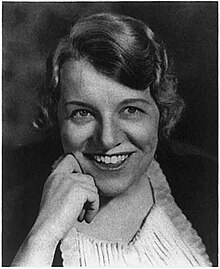Emma Bugbee
Emma Bugbee | |
|---|---|
 | |
| Born | May 19, 1888 |
| Died | October 6, 1981 (aged 93) |
| Alma mater | Barnard College |
| Occupation | Journalist |
Emma Bugbee (May 19, 1888 – October 6, 1981) was an American suffragist and journalist. She participated in and reported on the 1912 Suffrage Hike from New York City to Albany, New York.
Biography
She was born in Shippensburg, Pennsylvania. She later moved to New York. She graduated from Barnard College in 1909 and taught Greek courses at a high school in Methuen, Massachusetts.[1][2] She became a reporter for the New York Herald and the New York Herald Tribune.[3] She was the first woman report to be hired for the Herald's city room (Ishbel Ross would be the second).[4]
In 1914, she covered the Suffrage hike from Manhattan to Albany, New York.[1][4] In 1976, she moved to Warwick, Rhode Island.[1] She died on October 6, 1981, in Warwick, Rhode Island.[1][5]

See also
- List of suffragists and suffragettes
- List of women's rights activists
- Timeline of women's suffrage
- Timeline of women's rights (other than voting)
References
- ^ a b c d "Emma Bugbee". Retrieved 2009-08-01.
Emma Bugbee was born in Shippensburg, Pennsylvania, but lived most of her adult life in New York. She graduated from Barnard College and taught Greek courses at a high school in Methuen, Massachusetts. In 1976, she moved to Warwick, Rhode Island. In 1911, Bugbee got her first and only newspaper job with the New York Herald (which later became the New York Herald Tribune). Bugbee's first important newspaper assignment was to cover a weeks-long march of suffragists from New York City to Albany. Her feminist ideals were reinforced in her founding of the Newspaper Women's Club of New York. Bugbee was one of a handful of prominent female reporters who sought to expand the role of women in the male-dominated world of journalism that existed when she began her career. She was best known for her intimate coverage of Eleanor Roosevelt, beginning in 1933—amidst the early days of President Franklin D. Roosevelt's terms of office—and ending with a reminiscence of the former First Lady, written on the day of her death in 1962. Later in life, Bugbee's readership expanded to include young people. She was the author of the children's book Peggy Goes Overseas, published by Dodd in 1945. Emma Bugbee retired from the New York Herald Tribune two days before the newspaper ceased publication in 1966.
- ^ "Veteran sob sister dead at 93". Reporter. Vol. 92, no. 238. October 8, 1981. p. 13. Retrieved December 2, 2020 – via Newspapers.com.
- ^ "Died". Time magazine. October 16, 1981. Retrieved 2009-08-01.
Emma Bugbee, 93, suffragist and onetime high school teacher of Greek who broke through the barriers excluding women from city rooms in the early 1900s to become a reporter for the New York Herald, later the New York Herald Tribune; in Warwick, R.I. During her 56-year career, Bugbee was especially noted for her intimate coverage of Eleanor Roosevelt, who held her own press conferences for female journalists, banned from the all-male presidential briefings of the day.
- ^ a b "Two Case Histories, Ishbel Ross and Emma Bugbee: Women Journalists Ride the Rail with the Suffragettes". Education Resources Information Center. Retrieved 2009-08-01.
Bugbee walked with the suffragists on a week-long winter march from New York City to Albany
- ^ Fowler, Glen (October 10, 1981). "Emma Bugbee, 93. Reporter 55 Years". The New York Times. Retrieved 2009-08-01.
Emma Bugbee, a reporter whose colorful career on The New York Herald Tribune spanned 55 years, died on Tuesday in a Rhode Island nursing home at the age of 93. She retired two days before the newspaper ceased publication in 1966. Miss Bugbee was perhaps best known to readers ...
- 1888 births
- 1981 deaths
- 20th-century American historians
- American women journalists
- Barnard College alumni
- People from Methuen, Massachusetts
- American political writers
- Warwick, Rhode Island
- American suffragists
- American women's rights activists
- People from Shippensburg, Pennsylvania
- American women historians
- 20th-century American women writers
- Historians from Pennsylvania
- Historians from Massachusetts
